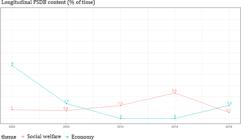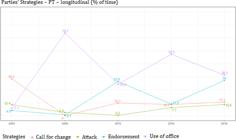A longitudinal analysis of the use of televised electoral advertising by the two political parties that have been the central actors in presidential elections in post-democratization Brazil: the Workers’ Party (hereinafter referred to using the Portuguese acronym the ‘PT’) and the Brazilian Social Democracy Party (hereinafter referred to using the Portuguese acronym the ‘PSDB’). Our objective is to identify patterns and changes in Brazilian electoral advertising between 2002 and 2018 with reference to Brazil’s system of free electoral advertising time (hereinafter referred to using the Portuguese acronym ‘HGPE’), more of which has been allocated to these two parties than to any other. Despite the increasing use of other forms of electoral campaigning, HGPE is central to presidential contests and demarcates political time and parties’ agendas. It is therefore relevant to understand how use of this campaign component has been developed over time, taking into account two factors: messages and strategies. Our quantitative content analysis considers 90 days of PT and PSDB block format advertising during the first rounds of five election contests. Our results reveal that changes in messaging tend to be decided on by the parties (with the PT emphasizing public policies and the PSDB emphasizing image building) whereas the strategies employed depend on the context of each election and are less specific to either party.
Elections; Brazil; election campaigning; television advertising, HGPE

 Thumbnail
Thumbnail
 Thumbnail
Thumbnail
 Thumbnail
Thumbnail
 Thumbnail
Thumbnail
 Thumbnail
Thumbnail
 Thumbnail
Thumbnail
 Source: Elaborated by the authors, with data from the CPOP-UFPR.
Source: Elaborated by the authors, with data from the CPOP-UFPR.
 Source: Elaborated by the authors, with data from the CPOP-UFPR.
Source: Elaborated by the authors, with data from the CPOP-UFPR.
 Source: Elaborated by the authors, with data from the CPOP-UFPR.
Source: Elaborated by the authors, with data from the CPOP-UFPR.
 Source: Elaborated by the authors, with data from the CPOP-UFPR.
Source: Elaborated by the authors, with data from the CPOP-UFPR.
 Source: Elaborated by the authors, with data from the CPOP-UFPR.
Source: Elaborated by the authors, with data from the CPOP-UFPR.
 Source: Elaborated by the authors, with data from the CPOP-UFPR.
Source: Elaborated by the authors, with data from the CPOP-UFPR.